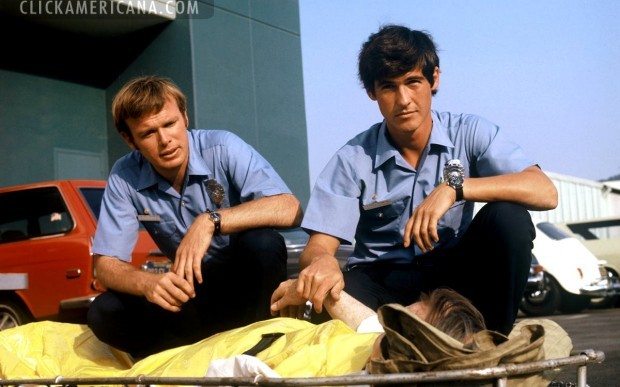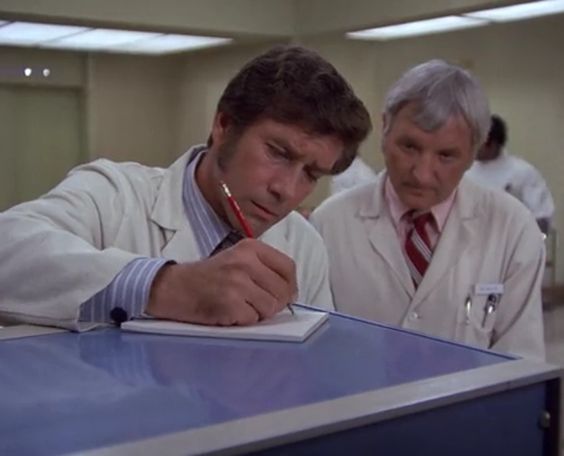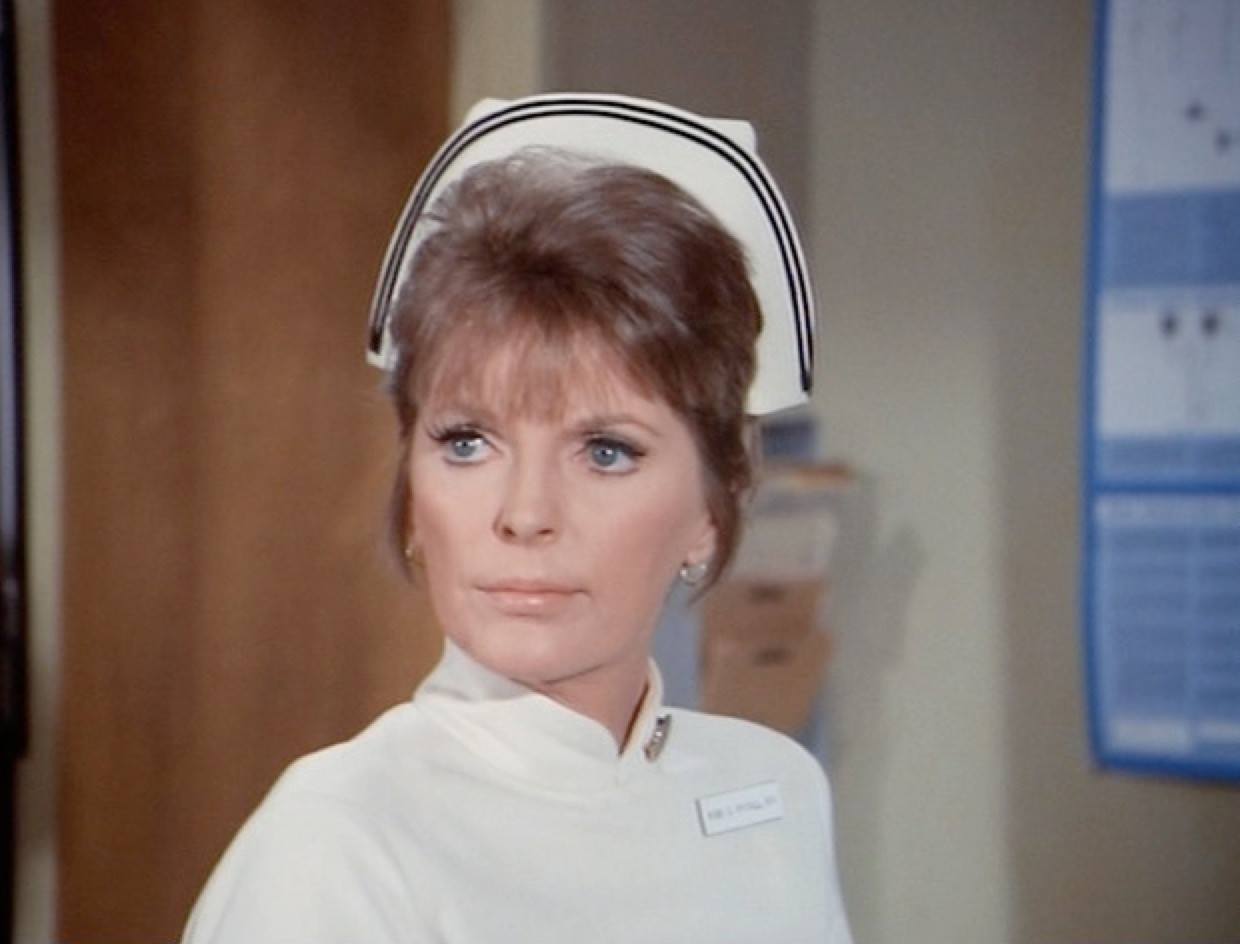[Ed. Note: I spent a great weekend at NECSS in New York, both imbibing knowledge and opinions on skepticism, giving a talk myself, and participating in three panels. Consequently, I didn’t have time to produce the voluminous new material that I usually do for every Monday. However, I realized that I had never covered a certain acupuncture study that was published last month. I remedy this situation now. This post might look familiar to some, but it’s never appeared in SBM. As for the Emergency! images? Well, that just shows my age, and, besides, I’m a fan of the show and am quite sure that the doctors at Rampart General Hospital would disapprove of this study, and that Paramedics John Gage and Roy DeSoto would not be willing to be trained for battlefield acupuncture. At least, I like to think so.]

You can be quite sure that John Gage and Roy DeSoto would laugh at you if you proposed that they carry acupuncture needles into the field. Note Gage’s disapproving look.
If there’s one form of quackery that is among the most “respected,” it has to be acupuncture. I’ve often speculated about why this might be, and the best that I can come up with is that doctors are a bit more open to acupuncture because it involves sticking actual needles into the body. It’s very easy to ignore the mystical, vitalistic BS about “redirecting the flow of qi” because doctors can easily handwave and postulate other, more scientific-sounding explanations, such as that it releases endorphins or adenosine. If that doesn’t work, then acupuncturists add electricity and thereby rebrand transcutaneous electrical nerve stimulation (TENS) as “electroacupuncture.” At the risk of being too anecdotal, a decade or two ago I was more open to acupuncture for this very reason. I never accepted the idea that sticking needles into specific points somehow redirected the flow of a mystical, magical “life energy,” but I could imagine that somehow sticking needles into the skin might “do something.” What, I wasn’t sure, but something. Of course, over the years, the more acupuncture studies and literature I read, the more I realized just how little “there” was there and how acupuncture is no more than a theatrical placebo.
One thing that I’ve always had a hard time understanding about acupuncture advocates is their desire to represent acupuncture as a useful treatment modality for emergency situations. The first time I encountered this sort of thinking was nearly ten years ago, when I first learned of “battlefield acupuncture.” Yes, it is exactly what it sounds like, and unfortunately it’s becoming more common in the military. Indeed, in 2017 flight surgeons are being trained in the technique, to be used on wounded soldiers in Afghanistan and wherever US troops are in harm’s way. Then there’s “emergency acupuncture,” which is, as it sounds, the use of acupuncture in the emergency room. I’ve deconstructed various studies of acupuncture use in the emergency room over the years, and it never ceases to amaze me how any emergency medicine physician could think this was a good idea. Well, here’s another one out of Australia by Cohen et al entitled, “Acupuncture for analgesia in the emergency department: a multicentre, randomised, equivalence and non-inferiority trial.”

You can be sure that Dr. Brackett is not writing an order for emergency acupuncture. If he did, you can be equally sure that Dr. Early (watching) would slap him upside the head.
Before I dig into the study itself, I often like to look at how the study is being reported in the press. The Conversation let the first author of the paper, Marc Cohen, Professor of Health Sciences, RMIT University, basically pimp his paper’s findings under the title “Emergency doctors are using acupuncture to treat pain, now here’s the evidence.” It’s basically a recounting of the study itself, touting it as the “largest of its kind in the world,” as though size guaranteed scientific rigor. First, he notes:
Using acupuncture to relieve pain involves placing needles in various parts of the body to stimulate the release of endorphins and other neurochemicals, which can act as the body’s naturally occurring pain relievers.
For generations various cultures around the world have used acupuncture to treat multiple conditions, including providing pain relief. And in Australia, it is reimbursed through the Medicare Benefits Schedule when administered by a medical doctor.
Of course, this is just the usual nonsense acupuncture apologists routinely lay down as a justification for their theatrical placebo. It’s basically handwaving and impressive, sciencey-sounding babble. He does, however, provide a succinct explanation of what an “equivalence” or “non-inferiority” study is:
Our trial was an “equivalence” study, which means we aimed to see if the different treatments were equivalent rather than seeing if they were better than placebo. We did this as it would not be ethical to give a placebo to people coming to an emergency department for pain relief.
This is, of course, a reasonable enough rationale to run a non-inferiority study. It’s the reason most such studies are run, because, for whatever reason (usually ethical), a placebo control arm can’t be used. I also note that this is a pragmatic trial as well. The idea is to show that the novel treatment is not inferior to existing standard-of-care treatments. What is usually done is to decide upon a non-inferiority margin, which is basically how much different by whatever scale measured than control an effect has to be before it is considered clinically inferior. It’s also reasonable to do a randomized controlled clinical trial using a design appropriate for a non-inferiority trial. Those are the pluses of the trial, such as they are. And, yes, it’s a decent-sized trial, although by no means really large. Indeed, that this is being touted as the largest such trial of its kind in the world rather speaks poorly of the state of acupuncture research. In any case, the study involved 1,964 patients who were assessed between January 2010 and December 2011, resulting in the randomization of 528 patients with acute low back pain (270 patients), migraine (92) or ankle sprain (166) to acupuncture alone (177 patients), acupuncture plus pharmacotherapy (178) or pharmacotherapy alone (173). (1,112 patients did not meet inclusion criteria, and 324 declined to participate.) The study itself was carried out at four different tertiary hospitals in Melbourne, Australia. Finally, the primary outcome measure assessed was pain at one hour (called T1 in the study). Clinically relevant pain relief was defined as achieving a pain score on a 10-point verbal numerical rating scale (VNRS) below 4, and statistically relevant pain relief as a reduction in VNRS score of greater than 2 units.

Nurse Dixie McCall, upon hearing that someone did a study of acupuncture in the emergency room. She does not approve.
The interventions themselves included:
Acupuncture alone. Acupuncture was provided by either a registered Chinese medicine practitioner or an ED physician with medical acupuncture qualifications. Treatment protocols (online Appendix), determined by a panel of specialist acupuncturists, provided predetermined points for each condition, as well as additional points for individualising treatment.
Pharmacotherapy alone. Pharmacotherapy was administered according to a standardised protocol based on the relevant national guidelines of the National Institute of Clinical Studies and the National Health and Medical Research Council. This protocol included first and second line drugs, as well as rescue medication administered at the discretion of the treating physicians, regardless of group allocation.
Combined treatment. Combined therapy included both acupuncture and pharmacotherapy, with acupuncture administered 15 minutes before or after pharmacotherapy to maintain blinding of the acupuncturist.
You can see the pragmatic trial design. The acupuncturists could individualize treatment within limits, and pharmacotherapy could also be personalized within the context of Australian national guidelines for the pharmacotherapy of pain. Here I consider it important to mention that I’ve discussed the use of pragmatic trials in acupuncture more times than I can remember. There is one requirement for a pragmatic trial, and it’s a requirement for a non-inferiority trial as well. That requirement is that the novel modality being tested against standard-of-care must already have been demonstrated to work in randomized clinical trials. As much as acupuncturists like to try to claim that acupuncture has been shown to work for the various health issues for which it is used, in reality when you look closely it’s not hard to see that the studies are most consistent with acupuncture “working” through placebo effects, not through any specific physiologic effect. As I like to say when discussing acupuncture studies, doing pragmatic studies on acupuncture is putting the cart before the horse. The same is true of non-inferiority studies. Show that acupuncture works in randomized clinical trials first, and then do the pragmatic or non-inferiority trials, if applicable.
So back to this study. There’s another aspect to the design of the study that should make you immediately question its results. Before I get to that, I’ll tell you the results. Quite predictably the trial showed noninferiority. Basically, acupuncture was not detectably inferior in short turn pain relief in any of the conditions tested. Depressingly, overall, only 16% of patients had clinically relevant pain relief and 36.9% statistically relevant pain relief at T1. That’s a rather low number. Then there were no statistically significant differences between the three groups. Now what would you think if I were to tell you that this was only a single-blind study? Neither the patients nor the practitioners were blinded to experimental group. Those who assessed pain scores were blinded, and so were the statisticians who carried out the analysis. Thus, the potential for placebo effects was maximized.
There’s also another little tidbit buried in the results that no one seems to be reporting on, and that’s the use of rescue analgesics. “Rescue” therapy is additional therapy given at the discretion of the treating physician after the primary therapy, usually because there hasn’t been sufficient improvement. In the case of this study:
The acupuncture only group received significantly more rescue medication therapy than the groups that received pharmacotherapy (at T1: p=0.016; after T1: p=0.008; Box 6). Oral opiate medication was offered as first line rescue medication to patients in the acupuncture group and parenteral opiates to the two pharmacotherapy groups.
Basically, the acupuncture-only group was nearly twice as likely to require rescue opioids as pharmacotherapy alone after T1. To me this suggests that acupuncture doesn’t work for the types of pain for which it was being tested. The authors grudgingly concede this possibility too, but can’t help but adding some hand waving in an effort to explain this result:
While pain reduction at T1 was similar for all three groups, patients in the acupuncture group were almost twice as likely to receive rescue analgesia. This may indicate that acupuncture was ineffective and patients sought alternative analgesia or that they were more likely to accept pharmacotherapy because they felt they had missed out on standard care, whereas patients who had already received oral opiates were reluctant to accept parenteral opiates. Patients treated with acupuncture who received rescue medication were classified as having received pharmacotherapy in the PP analysis, in which the equivalence and non-inferiority of groups were maintained, but we cannot discount the possibility that this may partly reflect the potentially self-limiting nature of the treated conditions.
So, basically what we have here is a pragmatic non-inferiority study that is only single blinded that purports to find no difference between acupuncture and pharmacotherapy for several different kinds of pain with different etiologies. (Seriously, migraine headaches are very different from ankle sprains and low back pain.) The lack of full double-blinding easily explains the positive result of the trial as very likely due to placebo effects, after all. Moreover, this study finds significantly increased use of rescue treatments for the acupuncture-alone group, which implies that the subjects in the acupuncture-alone group were not getting adequate pain relief.
Of course, none of this tops the authors from concluding:
There is a clear demand for analgesia in the ED and a multimodal approach is desirable given concerns about the use of opioids and the potential for addiction. Some Australian EDs already offer acupuncture as an alternative when trained staff are available, and the relative efficacy, acceptability and safety of acupuncture support its playing a role in non-pharmacological analgesia in acute care settings. Acupuncture may also improve patient satisfaction by providing analgesia to patients with contraindications for certain drugs, and for those who prefer acupuncture. Pain management in EDs in general must be improved. The potential role of acupuncture should also be further explored, including determining the conditions in which it is most useful and the feasibility of employing it in emergency settings, including acupuncture training for emergency physicians and allied health personnel.
I’ll agree that there’s a clear demand for effective analgesia in the emergency room, although for short term use for pain relief opioids are acceptably safe. Increasingly, there has been a narrative among advocates of “integrative medicine” that equates nonpharmacological methods of pain management with woo. What this study does is basically to use the opioid epidemic as an excuse for embracing quackery. Quackademic medicine marches on.
Oh, and, given that this is the Fourth of July weekend, if you or anyone you know happen to blow a finger off with fireworks, demand real analgesia.
